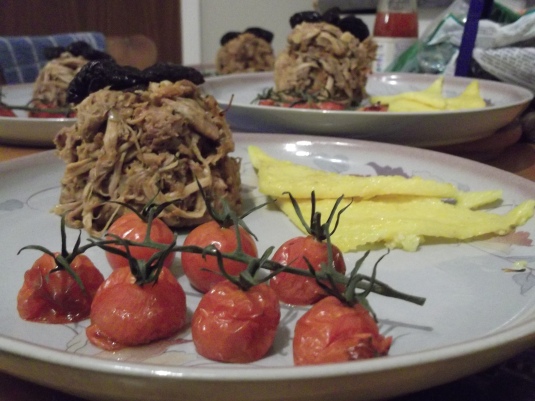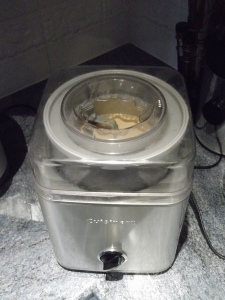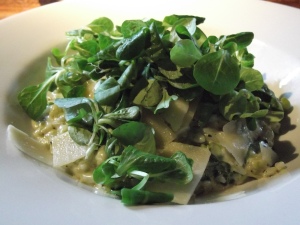I find designing main courses quite hard. To cook something exciting- not just some meat, some potatoes/rice/beans, some veg, perhaps a sauce- really requires some thought. Traditional cooking can taste lovely, but something like cassoulet or a homely stew is not fundamentally interesting. Even recipe books are not that inspiring here. It might just be that, in some sense, cooking has evolved to suit our tastes, and our body likes to have protein, carbohydrate, and vitamins and minerals all in the same meal. But that doesn’t make the meal novel and creative. Starters and puddings are much more fun, since you can play around with ideas, and there aren’t many preconceptions as to what the course should be like. So recently, I’ve tried taking different things I have used in starters, or as part of other meals, and combining them to make a fancier main meal. Perhaps a little strange some times, but much more interesting.
My latest attempt has been using pulled pork. Pulled pork is slow cooked pork, which become tender enough to pull apart, and is then mixed with a sauce or spices. Normally I make this as a fajita or sandwich filling, and it’s great for feeding a crowd, as you start off with such a large piece of pork. The sauce I use in the pork adds a huge amount of complexity- chocolate, smoke, spiciness, earthiness, sweetness, and nutty flavours are all there. It’s always gone down very well with friends who have ended up with some for lunch, so why wouldn’t it make a good main course? Since it is a little similar in texture to pork rillettes, or a course pâté, I thought some sort of bread/chutney would help bring out the flavours.
Polenta toasts are to be the accompaniment here. In the same way you might have pâté on toast as a starter, this makes the main course ‘strange pâté on strange toast’. Polenta is maize flour, so making toast out of it is not completely out of left field. I’ve also tried polenta chips before, which have worked very well. You end up with a crispy yet granular texture, but a much denser texture than normal toast. Also, the process cooking polenta is great fun, as it can only be described as ‘volcanic’- if you do cook it, be sure to put a lid on the saucepan. Once cooked and set, just finish off under a grill, or frying pan, to get your thin and crispy toasts.
With some roast cherry tomatoes and prunes to provide the ‘chutney’, the course is complete. I really liked it, as did the others who had it, but I will admit the texture of the polenta was a little strange with the smooth pulled pork- definitely an interesting course. If you are wondering what to cook, it can be as simple as just taking your favourite starter and turning the dish into a main.
Pulled Pork with Prunes and Polenta Toasts
Serves 6, with a good amount of pulled pork left over. Takes a long time, but the results are well worth it. The recipe for pulled pork is based on one from BBC Good Food.
Ingredients
1 pork shoulder (~1.5kg)
1 tbsp tomato puree
1 litre chicken stock
1 orange
1 cinnamon stick
1 sprig thyme
2 onions
250g pack cherry tomatoes
2 corn tortillas
50g flaked almonds
50g raisins
2tsp each ground coriander, cumin
1tbsp chipotle chilli paste
25g plain chocolate
9 prunes, best quality you can reasonably get
200g uncooked polenta
1 litre vegetable stock
24 cherry tomatoes, best quality you can reasonably get
oil, for frying
Recipe:
1. Soften the pork. In a large casserole dish, mix the chicken stock, tomato purée, zest and juice of the orange, and cinnamon stick. Add the pork shoulder, top up with boiling water, then simmer for approximately 5 hours, until the pork is tender and falling apart. Remove the pork from the casserole, allow to cool, then pull apart with your fingers, discarding the fat.
2. Make the sauce. Dice the onions, fry, then add, with the chocolate and chipotle sauceto a food processor. Dry-fry the tomatoes until they blister, fry the tortillas, and add to the food processor. Heat some oil in a pan, add the coriander and cumin, then the raisins and almonds. Heat until the raisins absorb the oil, then add to the food processor. Whizz until coarse, and add around 3tbsp of the pork stewing liquid. Mix the sauce into the pork.
3. Make the polenta toasts. In a pan (with a lid on), heat the polenta along with 1 litre of vegetable stock, stirring occasionally. The polenta will spit, so make sure to keep the lid on. After an hour, pour onto a baking tray to cool, spreading as thin as possible. When cooled (~1hr), cut the polenta into triangles. Heat some oil in a frying pan, and fry the polenta toasts for around 4 minutes each side until crispy. You can also do these in a griddle pan for prettier toasts, but I found the charred effect taste too strong.
4. Assemble the dish. Roast the good quality cherry tomatoes for around 30 minutes. Put some pulled pork in a mug, then turn over onto a plate. Slice the prunes, and place them on top, then add the roasted cherry tomatoes and polenta toasts.












